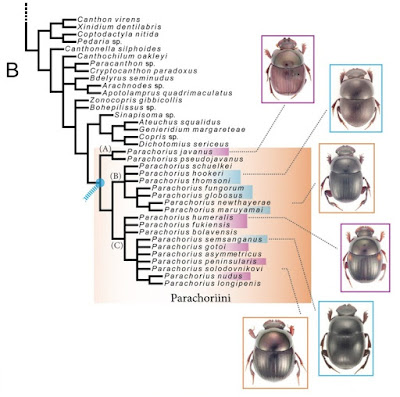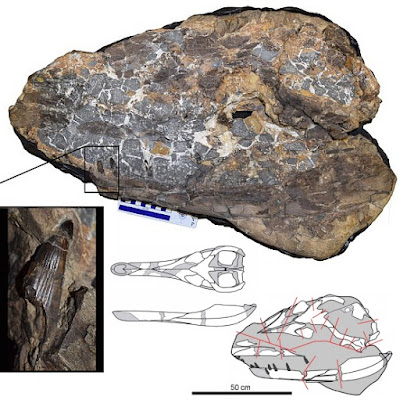[Most Recent Entries] [Calendar View]
Wednesday, October 4th, 2017
| Time | Event | ||||
| 8:56a | [Entomology • 2017] A Cybertaxonomic Revision of the New Dung beetle Tribe Parachoriini (Coleoptera: Scarabaeidae: Scarabaeinae) and Its Phylogenetic Assessment Using Molecular and Morphological Data
Abstract Two Oriental dung beetle genera: Parachorius Harold, 1873 and Cassolus Sharp, 1875 have long had an ambiguous tribal position in Scarabaeinae (Coleoptera: Scarabaeidae), but have never been considered as closely related. A recently discovered species representing the morphological link between the two genera gave a hint to their possible close affiliation. To assess phylogenetic and taxonomic placement of these genera, I conducted phylogenetic analyses of global dung beetle samples using morphological (134 taxa, 232 characters) and molecular (551 terminals, 8 gene regions) data. Both morphological and molecular analyses strongly support the monophyly of Parachorius + Cassolus. This leads to the synonymy of Parachorius with Cassolus new synonymy, and resulted in the new generic concept for Parachorius. The isolated phylogenetic position of Parachorius and its morphological distinctiveness from all other known Scarabaeinae tribes suggest recognition of a new tribe, Parachoriini new tribe, to maintain the stability of tribal classification in dung beetles. Investigation of old and recent material of Parachorius revealed a large number of undescribed species and the need for a taxonomic revision of this genus. The revision of Parachorius, powered by the 3i cybertaxonomic tool, is presented in this study. The revised Parachorius is comprised of 19 species from the Oriental and southeastern Palaearctic Regions, of which seven are newly described (P. asymmetricus new species, P. bolavensis new species, P. longipenis new species, P. newthayerae new species, P. pseudojavanus new species, P. schuelkei new species, and P. solodovnikovi new species). Three species names in Parachorius are synonymized, namely, P. fungorum Kryzhanovsky & Medvedev, 1966 = P. krali Utsunomiya & Masumoto, 2001 new synonymy; P. thomsoni Harold, 1873 = P. lannathai Hanboonsong & Masumoto, 2001 new synonymy; and P. peninsularis (Arrow, 1907) = C. pongchaii Masumoto, 2001 new synonymy. Two species originally described in Cassolus (C. sumatranus and C. minutus) are transferred to the genus Panelus Lewis, 1895. The rank of the genus Macropanelus is lowered to a subgenus within Panelus (i.e. Panelus (Macropanelus) new status). Keywords: Coleoptera, Dung beetles, Scarabaeinae, systematics, cybertaxonomy, new tribe Sergei Tarasov. 2017. A Cybertaxonomic Revision of the New Dung beetle Tribe Parachoriini (Coleoptera: Scarabaeidae: Scarabaeinae) and Its Phylogenetic Assessment Using Molecular and Morphological Data. Zootaxa. 4329(2); 101–149. DOI: 10.11646/zootaxa.4329.2.1 | ||||
| 3:09p | [Paleontology • 2017] Ieldraan melkshamensis • A New Metriorhynchid Crocodylomorph from the Oxford Clay Formation (Middle Jurassic) of England, with Implications for the Origin and Diversification of Geosaurini
Abstract Metriorhynchids are an extinct group of Jurassic–Cretaceous crocodylomorphs secondarily adapted to a marine lifestyle. A new metriorhynchid crocodylomorph from the Oxford Clay Formation (Callovian, Middle Jurassic) of England is described. The specimen is a large, fragmentary skull and associated single ramus of a lower jaw uniquely preserved in a septarian concretion. The description of the specimen reveals a series of autapomorphies (apicobasal flutings on the middle labial surface of the tooth crowns, greatly enlarged basoccipital tuberosities) and a unique combination of characters that warrant the creation of a new genus and species: Ieldraan melkshamensis gen. et sp. nov. This taxon shares numerous characters with the Late Jurassic–Early Cretaceous genus Geosaurus: tooth crowns that have three apicobasal facets on their labial surface, subtly ornamented skull and lower jaws elements, and reception pits along the lateral margin of the dentary (maxillary overbite). Phylogenetic analysis places this new species as the sister taxon to Geosaurus. The new taxon adds valuable information on the time of origin of the macrophagous subclade Geosaurini, which was initially thought to have evolved and radiated during the Late Jurassic. The presence of Ieldraan melkshamensis, the phylogenetic re-evaluation of Suchodus durobrivensis as a Plesiosuchus sister taxon and recently identified Callovian Dakosaurus-like specimens in the Oxford Clay Formation, indicate that all major Geosaurini lineages originated earlier than previously supposed. This has major implications for the evolution of macropredation in the group. Specifically, we can now demonstrate that the four different forms of true ziphodonty observed in derived geosaurins independently evolved from a single non-functional microziphodont common ancestor. Keywords: Ieldraan, Melksham monster, Geosaurus, Geosaurini, Jurassic, macrophagy
Systematic palaeontology Superorder Crocodylomorpha Hay, 1930 (sensu Walker 1970) Suborder Thalattosuchia Fraas, 1901 (sensu Young & Andrade 2009) Family Metriorhynchidae Fitzinger, 1843 (sensu Young & Andrade 2009) Subfamily Geosaurinae Lydekker, 1889 (sensu Young & Andrade 2009) Tribe Geosaurini Lydekker, 1889 (sensu Cau & Fanti 2011) Subtribe Geosaurina subtr. nov. Type genus. Geosaurus Cuvier, 1824 (sensu Young et al. 2012). Geological range. Middle Callovian to Valanginian (34 myr duration). Geographical range. European endemic (UK, Germany and France). Genus Ieldraan gen. nov. Type species. Ieldraan melkshamensis gen. et sp. nov. Derivation of the name: ‘Older One’. Ieldra, Old English for older; and an, Old English for one, referring to the stratigraphically older age of this new genus compared to its close relative Geosaurus. Ieldraan melkshamensis sp. nov. 1888 Metriorhynchus moreli Eudes-Deslongchamps; Lydekker: 97. Derivation of name: ‘Older One from Melksham’, epithet translated from Latin, locative case. Conclusions: Based on our description of a long overlooked and misinterpreted specimen (NHMUK PV OR 46797), we establish the new taxon Ieldraan melkshamensis gen. et sp. nov. Despite the poor state of preservation, we demonstrate that this late Middle Jurassic taxon from the OCF shows remarkable similarities with the Late Jurassic genus Geosaurus. Ieldraan and Geosaurus are found to be sister taxa in a new European endemic, Callovian–Valanginian geosaurin lineage that we name Geosaurina subtr. nov. The morphology and stratigraphical occurrence of Ieldraan melkshamensis, combined with our phylogenetic analysis, demonstrate that numerous adaptations linked to macrophagy had already evolved in Geosaurini by the Callovian stage. This suggests that the diversification of the tribe was perhaps less abrupt than previously thought, but rather had a longer temporal and phylogenetic fuse. We also show that the evolution of ziphodonty followed a different path than previously hypothesized. The new information presented here indicates that four different true ziphodont morphologies in the derived Late Jurassic geosaurins independently evolved from a unique non-functional microziphodont common ancestor. Davide Foffa, Mark T. Young, Stephen L. Brusatte, Mark R. Graham and Lorna Steel. 2017. A New Metriorhynchid Crocodylomorph from the Oxford Clay Formation (Middle Jurassic) of England, with Implications for the Origin and Diversification of Geosaurini. Journal of Systematic Palaeontology. DOI: 10.1080/14772019.2017.1367730 |
| << Previous Day |
2017/10/04 [Calendar] |
Next Day >> |





